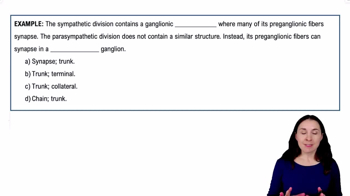Review of the Sympathetic and Parasympathetic Divisions definitions Flashcards
 Back
BackReview of the Sympathetic and Parasympathetic Divisions definitions
1/15
Terms in this set (15)
- Dual innervationRefers to organs receiving inputs from both sympathetic and parasympathetic nervous systems.
- Sympathetic fibersOriginate from spinal cord segments T1-L2, increase heart rate, and have short preganglionic fibers.
- Parasympathetic fibersOriginate from cranial and sacral regions, decrease heart rate, and have long preganglionic fibers.
- Preganglionic fiberNerve fiber that extends from the central nervous system to a ganglion.
- Postganglionic fiberNerve fiber that extends from a ganglion to an effector organ.
- Sympathetic trunkChain of ganglia located near the spinal cord where sympathetic fibers synapse.
- Collateral gangliaGanglia where some sympathetic fibers synapse, bypassing the sympathetic trunk.
- Terminal gangliaGanglia located near or on effector organs where parasympathetic fibers synapse.
- Splanchnic nervesNerves that bypass the sympathetic trunk to synapse in collateral ganglia.
- Effector organTarget organ or tissue that responds to nerve impulses.
- Cranial regionArea of the brainstem where parasympathetic fibers originate.
- Sacral regionLower spinal region where parasympathetic fibers originate.
- Fight or flight responsePhysiological reaction to perceived harmful events, activated by sympathetic nervous system.
- Rest and digest effectState of relaxation and digestion promoted by parasympathetic nervous system.
- SynapseJunction between two nerve cells where impulses pass by diffusion of neurotransmitters.


